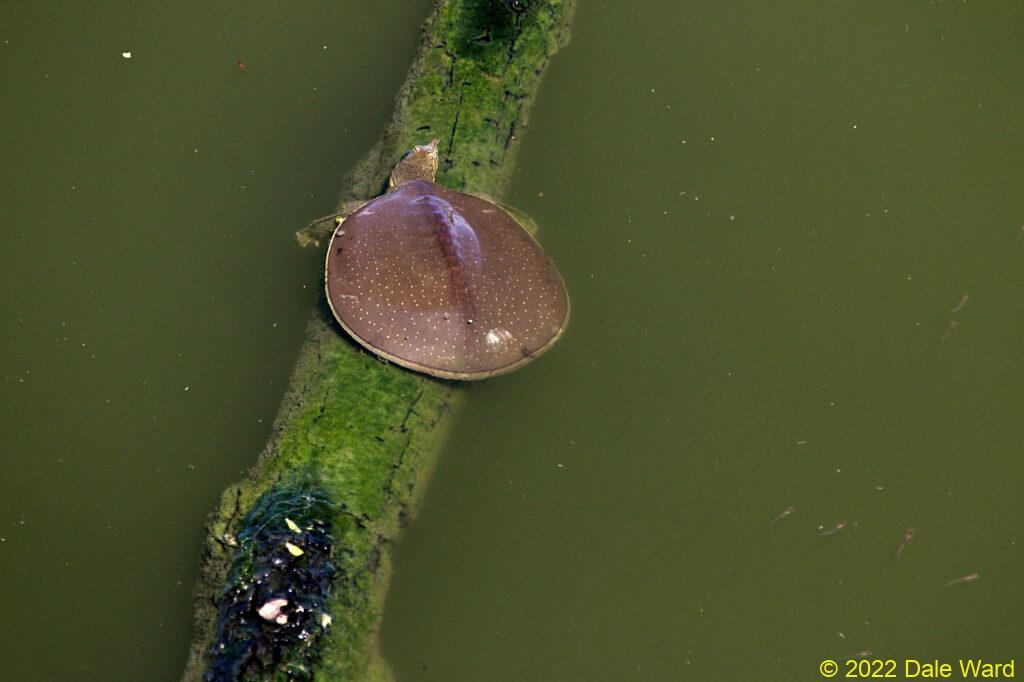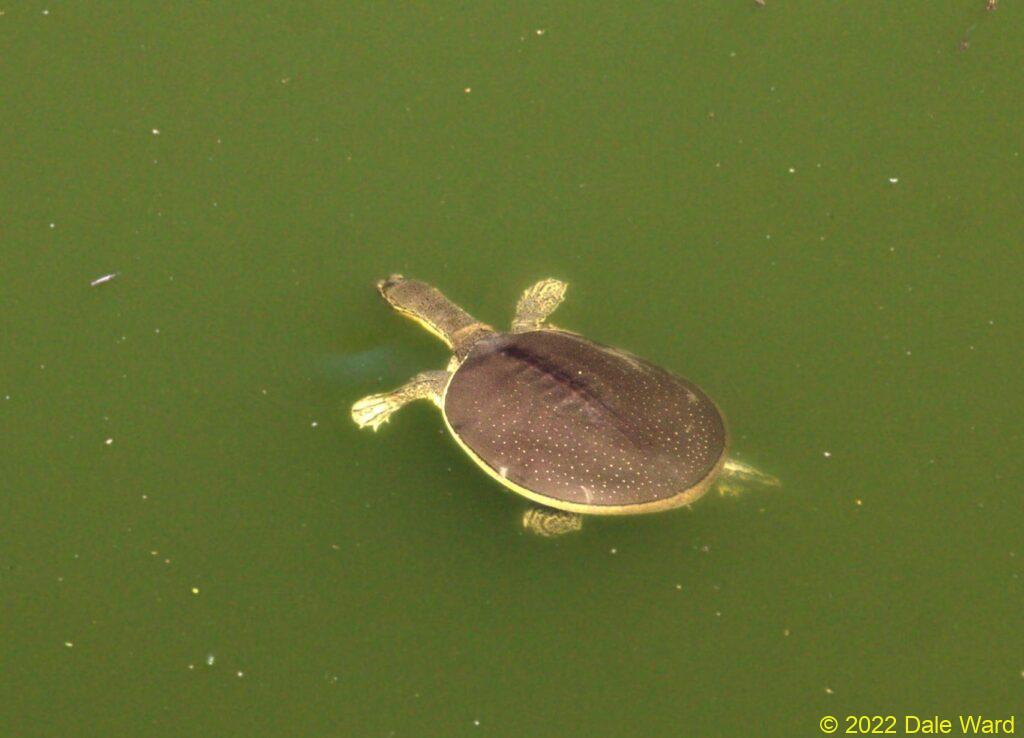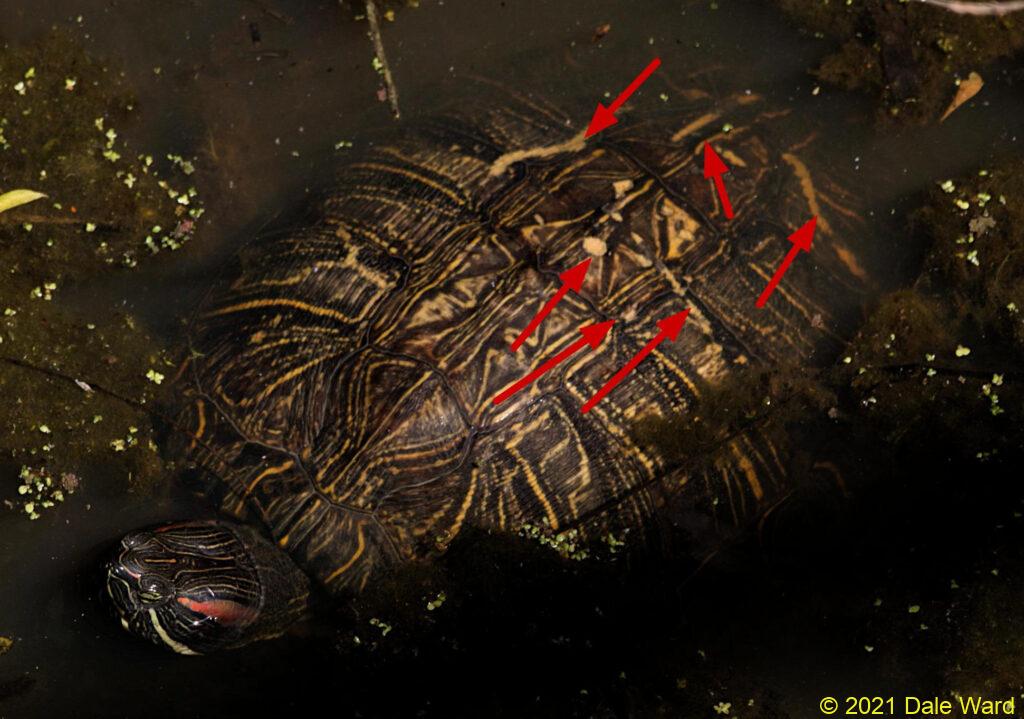Spiny Softshell Turtles (Apolone spinifera)
Thoughts on Softshell Turtles and Alligators - how do they coexist?
 Spiny Softshell Turtle basking on a log
Spiny Softshell Turtle basking on a log
I started thinking about Softshell Turtles when I was writing about the Red-eared Slider Turtles with possible Alligator tooth marks on them. If the marks on the shells of Sliders really were toothmarks, then how on Earth do Softshell Turtles coexist with Alligators?
As their name suggests, Softshell Turtles don’t have hard exterior shell scutes like other Turtles. To use a Medieval armour analogy, it’s as though Softshell Turtle shells are padded gambesons, while other Turtle shells are made of plate armour.
 Spiny Softshell Turtle swimming. Look how long it’s neck is!
Spiny Softshell Turtle swimming. Look how long it’s neck is!
It was my understanding that Softshells ‘traded’ the relatively clunky and heavy, stiffly-armored shells for their lighter, reduced shells so that the Turtles would be more nimble in the water.
Does that extra agility make it harder for Alligators to catch Softshell Turtles, is that the way it’s working? That seemed strange to me…the Alligators I’ve seen have been pretty nimble. More nimble than Turtles, anyway.
After reading Scheyer etal’s 2007 paper, I see that I was missing an important part of the picture.
Scheyer etal found that Softshelled Turtles had boney layers in their shells, beneath the tough, rubbery shell exteriors. And the Softshelled Turtles also had a layer of collagen fibers that were a lot like, well, plywood.
Here’s what Scheyer etal say:
Strikingly, this peculiar fibre bundle arrangement strongly resembles artificial reinforced fibre-strengthened polymeric materials that combine superior mechanical strength with low weight. We hypothesise that the evolutionary success of soft-shelled turtles is tied to this plywood-like structure of the skin and bone.
If I’m reading this correctly, it means that the Softshell Turtle shells could be lighter and stronger than ‘conventional’ Turtle shells. The added strength also meant that the Softshell Turtles did not need the high dome shape of conventional Turtle shells for a given level of crush resistance.
Here’s Scheyer talking about Softshell Turtle shells’ resistance to crushing and cracking:
…according to the striking parallels to man-made fibre-reinforced composite materials, the plywood-like structure may have some kind of biomechanical advantage, be it a heightened resistance against crushing or crack prevention, or simply an increase in stability of the flattened carapacial disk…
We hypothesise that the evolutionary success of soft-shelled turtles is tied to this plywood-like structure of the skin and bone. It may have been the key adaptation that allowed trionychids to greatly reduce and flatten their protective shell, resulting in decreased mineral needs for hard tissues, improved camouflage and hunting performance, biomechanical stability of the shell, as well as overall increased agility and short-term swimming boosts.
So, for a given weight of Turtle, a Softshell Turtle should have a greater diameter than a ‘normal’ Turtle of the same weight. I’d think that an Alligator would be less likely to be able to swallow-whole a Softshell Turtle of a given weight than a ‘normal’ Turtle. Swallowing a Softshell whole would be like trying to swallow a flat manhole cover of a shell, while swallowing a ‘normal’ Turtle whole would be more like swallowing a raisin.
I’d think, though, that the Softshell Turtle’s rubbery exterior would increase the chances of an Alligator’s teeth being able to grip the shell vs the hard exterior scutes of a ‘normal’ Turtle, and then perhaps to crush it.
With the ‘normal’ Turtle, I would expect that the Alligator’s teeth would tend to slide off of the Turtle’s shell, as I suspect happened with the Red-eared Slider in this photo:
 Red-Eared Slider (Trachemys scripta elegans) with possible tooth-scarring on the shell, marked by red arrows. Some of the marks, near the back end of the carapace, look like the teeth dragged and scraped along the shell.
Red-Eared Slider (Trachemys scripta elegans) with possible tooth-scarring on the shell, marked by red arrows. Some of the marks, near the back end of the carapace, look like the teeth dragged and scraped along the shell.
So are ‘normal’ Turtle shells and their geometries analogous to face-hardened armour in tanks? The high dome of the ‘normal’ Turtle’s shell creating an arch that resists crushing, while the hardened exterior scutes and angles of the domed shell make it more likely that the Alligator’s teeth will slide off of the shell, sort of like an anti-tank shell bounces off when hitting a highly angled piece of armour on a tank?
I don’t know. But, yeah, I think there have got to be all sorts of interesting trade-offs going with Turtle shell materials and geometries.
Sources: *Torsten M.Scheyer, P.Martin Sander, Walter G.Joyce, Wolfgang Böhme, Ulrich, Witzel. 2007. A plywood structure in the shell of fossil and living soft-shelled turtles (Trionychidae) and its evolutionary implications. Organisms Diversity & Evolution. Volume 7, Issue 2, 2 August 2007. Pages 136-144.